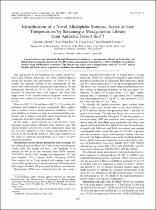Identification of a novel alkaliphilic esterase active at low temperatures by screening a metagenomic library from Antarctic desert soil
| dc.contributor.author | Heath, Caroline | |
| dc.contributor.author | Hu, Xiao Ping | |
| dc.contributor.author | Cary, Craig | |
| dc.date.accessioned | 2023-05-31T13:37:08Z | |
| dc.date.available | 2023-05-31T13:37:08Z | |
| dc.date.issued | 2009 | |
| dc.identifier.citation | Heath, C. et al. (2009). Identification of a novel alkaliphilic esterase active at low temperatures by screening a metagenomic library from Antarctic desert soil, Applied and Environmental Microbiology, 75 (13), 4657-4659. 10.1128/AEM.02597-08 | en_US |
| dc.identifier.issn | 1098-5336 | |
| dc.identifier.uri | 10.1128/AEM.02597-08 | |
| dc.identifier.uri | http://hdl.handle.net/10566/8979 | |
| dc.description.abstract | The cold deserts of the McMurdo Dry Valleys, South Victoria Land, Eastern Antarctica, are widely acknowledged as having the harshest soil environments on Earth (6, 8, 26). Despite the apparent hostility of the environment, we and others have reported both unexpectedly high biomass (9) and phylogenetic diversity (1, 19, 24, 29) in Antarctic soils. The presence of numerous novel taxa suggests that these soils might prove to be valuable sources of genetic material for mining novel industrial enzymes active at low temperatures (9, 23). Esterases (EC 3.1.1.1) and lipases (EC 3.1.1.3) catalyze the hydrolysis and synthesis of ester compounds. Their applications in industry cover a broad spectrum, including as detergent additives, in food processing, in environmental bioremediation, and in biomass and plant waste degradation for the production of useful organocompounds (3, 16). | en_US |
| dc.language.iso | en | en_US |
| dc.publisher | American Society for Microbiology | en_US |
| dc.subject | Biotechnology | en_US |
| dc.subject | Climate change | en_US |
| dc.subject | Diversity | en_US |
| dc.subject | Agriculture | en_US |
| dc.subject | Antarctic desert | en_US |
| dc.title | Identification of a novel alkaliphilic esterase active at low temperatures by screening a metagenomic library from Antarctic desert soil | en_US |
| dc.type | Article | en_US |

